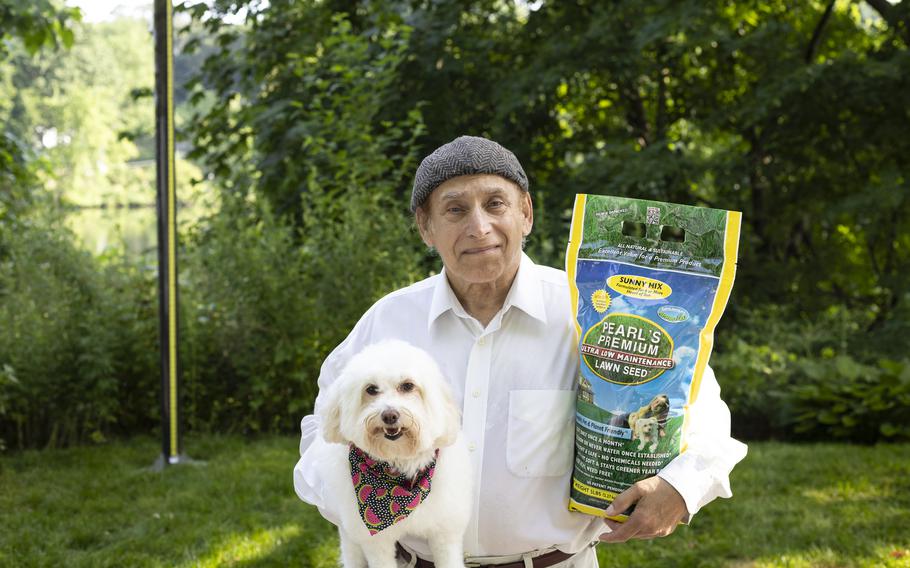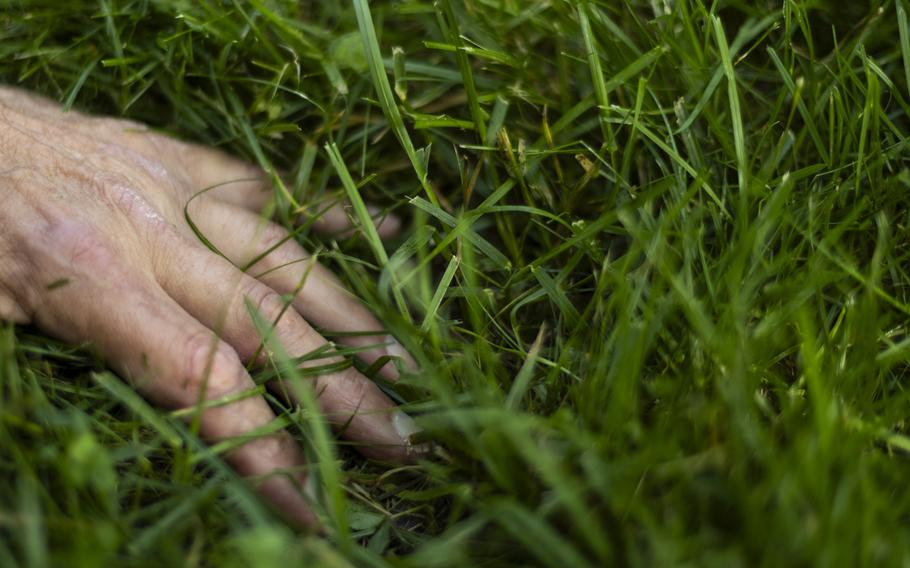
Jackson Madnick with his dog, Zoe, who is the “spokesdog” for Pearl’s Premium, the grass mix that he developed. His grass seed mix can thrive without chemicals and with minimal watering. (Iaritza Menjivar/For The Washington Post)
Jackson Madnick, a 76-year-old resident of Wayland, Mass., rarely mows, waters or fertilizes his lawn, and he never sprays it with weed killers. Even so, his grass looks like a thriving, emerald-green meadow year-round. It emerges green from under the snow, and it keeps its vibrant hue in summer droughts. If that sounds too good to be true, Madnick has even more surprises to share: He bred this grass himself.
Madnick became a citizen grass scientist after his cat, Kitty, died of cancer in 1999.
“I moved into a house near a golf course, and I had a cat that went outside all the time,” he says. “And within two months of moving in there, she got a huge lump and she died.” His veterinarian suggested that lawn chemicals may have played a part.
As he researched his cat’s death, Madnick, a multimedia show designer who planned concerts, fireworks, theme park shows and other events, learned that the traditional American lawn is a lot less green than it appears.
When fertilizers and herbicides became widely available after World War II, manufacturers were eager to sell them not only to farmers but also to homeowners, says Nancy Gift, a weed ecologist who is executive director of Cornell Cooperative Extension. To drive up sales, they promoted perfect plush green turfs as a status symbol. But the amount of water and chemicals needed to keep grass beautiful can be harmful to the environment, according to the Environmental Protection Agency.
So Madnick wondered if he could redesign lawn care from the ground up. He wanted to find a grass that didn’t need chemicals and required little water.
He read up on turf science, spending hours in libraries. He planted different varieties of grass seed in paper coffee cups in his backyard.
“I grew close to 70 kinds of grasses from around the world that supposedly needed less chemicals and less water,” he says. But none of those grasses liked his harsh treatment. “A year later, after a hot summer, they were all dead.” The only survivors were three varieties that thrive in the desert — cactus-like species that were too prickly to walk on.
Madnick kept at it, though. He asked several turf scientists for hardy-grass recommendations and narrowed his list to seven varieties, including red fescue, tall fescue and Kentucky blue. Hoping to find a winning combination, he planted those seeds in different ratios.
“I had a theory that maybe the right seeds in the right proportions might have an interaction and do something different,” he says. But the mixes died, just like the solo grasses before them. He doubled down, covering his patio with numbered pots for different ratios of his seven-seed mix and logging the proportions, the amount of water he used and how long each mix survived. Madnick wasn’t secretive about his efforts, but he did keep it fairly private. “I didn’t want people to think I was a mad scientist,” he says.
The work was time-consuming. “I did hundreds of these at a time, and it did take me a good portion of the day,” Madnick says. His partner, Betsy West, occasionally questioned the endeavor. “Why are you spending so much time on this?” she would ask, when yet another batch wilted and died.
“A couple of times I almost gave up,” Madnick says. “But then I read a book about Thomas Edison that said that if he stopped one experiment short of discovering the lightbulb, he might not have ever discovered the lightbulb. It was perseverance and luck. So, I continued.”
Five years and 7,000 mixes later, Madnick’s efforts paid off. One container grew a lush green grass with an elegant thin blade. Madnick couldn’t believe his luck, but when he picked up the pot, he knew why it was thriving: “The roots were so long, they were coming out of the bottom of the pot.”
When planted in the right proportions, the grasses formed a symbiotic relationship that allowed them to sprout unusually long and robust roots. Typical lawn grasses grow 3- to 4-inch roots; Madnick’s mix boasted roots nearly twice that long. When the mix is planted in soil rather than a pot, the roots reach the groundwater, making the lawn more resilient and self-reliant. “From that one ‘aha’ batch, I grew 3,000 more trials until finally I optimized the interaction,” he says.

Jackson Madnick carefully selected seeds for Pearl’s Premium that are native to North America and are more tolerant to drought, disease, salt and bugs than traditional lawn grasses. (Iaritza Menjivar/For The Washington Post)
He kept tweaking the mix until the roots became 12 to 14 inches long, then he began selling the mix as Pearl’s Premium. He named the grass after his daughter and his mother, who shared the name “Pearl.” “My mother was an environmentalist and she taught me to care about the planet,” Madnick says.
The key lies in the mix. “When you have more species growing together, you actually have a greater ecosystem function,” says Rebecca Barak, a conservation scientist at the Chicago Botanic Garden who studies seed mixes for prairie restoration.
Her own group is experimenting with mixes of fescues as an alternative to the more commonly used lawn seeds such as Kentucky bluegrass. Fescues, she says, are tough and slow-growing grasses, and their presence in Madnick’s mix could explain why the grass is hardy and low-maintenance.
“They don’t really require fertilizing and they do grow these really deep and kind of thick mats of roots,” she says. “Because they grow so slowly, they just don’t use as much water.”
Madnick says Pearl’s Premium requires initial watering to sprout its uber-roots but needs little care afterward.
“You can mow it, but you don’t have to,” he says. “If you don’t mow it, it flips over and becomes a meadow.”
As Madnick honed his combo, the roots kept growing longer, gradually reaching 3-, 4- and even 5-feet-long. He began selling it to drought-prone places such as Utah, California and countries in the Middle East. Over the years, Pearl’s Premium has won several awards, including a $50,000 prize at the MassChallenge competition in 2010 and the Boston Museum of Science “Invented Here” innovation award in 2013.
And Madnick continues to work on his mix. He began adding some organic fertilizers to his seeds, to help the grass grow even longer roots. Eventually, the roots became so extensive that he couldn’t experiment in pots anymore, so he moved on to using long, transparent plastic tubes that allow him to see the roots and measure their progress. Now in its seventh generation, the grass grows roots that are at least 6 feet deep, but Madnick wants to see exactly how long they can grow. He and West now run the company and the experiments together, from inside their home.
“In my kitchen, I have a clear plastic tube that’s 8 feet tall, and I’m growing it in the tube to see if it can get 8 or more feet,” he says. “They might actually grow longer than that, but that’s the biggest tube I could buy without gluing tubes together.”